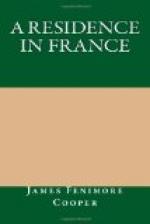[Footnote 16: This ancient family still exists, though much shorn of its splendour, by the alienation of its estates, in consequence of the marriage of Charlotte de Montmorency, heiress of the eldest line, with a Prince of Conde, two centuries since. By this union, the estates and chateaux of Chantilly, Ecouen, etc., ancient possessions of the house, passed into a junior branch of the royal family. In this manner Enghien, a seigneurie of the Montmorencies, came to be the title of a prince of the blood, in the person of the unfortunate descendant of Charlotte of that name. At the present time, besides the Duc de Montmorency, the Duc de Laval-Montmorency, the Duc de Luxembourg, the Prince de Bauffremont, the Prince de Tancarville, and one or two more, are members of this family, and most of them are, or were before the late revolution, peers of France. The writer knew, at Paris, a Colonel de Montmorency, an Irishman by birth, who claimed to be the head of this celebrated family, as a descendant of a cadet who followed the Conqueror into England. There are two Irish peers, who have also pretensions of the same sort, though the French branches of the family look coolly on the claim. The title of “First Christian Baron,” is not derived from antiquity, ancient as the house unquestionably is, but from the circumstance that the barony of Montmorency, from its local position, in sight of Paris, aided by the great power of the family, rendered the barons the first in importance to their sovereign. The family of Talleyrand-Perigord is so ancient, that, in the middle ages, when a King demanded of its head, “Who made you Count de Perigord?” he was asked, by way of reply, “Who made you King of France?”—God! I think I should have hesitated on the score of taste about establishing myself in a house of the Montmorencies, but Jonathan has usually no such scruples. Our own residence was but temporary, the hotel being public.]




